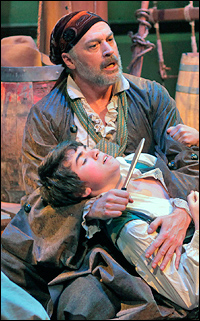
*
It's a cinch that the new stage adaptation of Robert Louis Stevenson's classic pirate tale Treasure Island, now playing at the Irondale Center in Brooklyn, will have some pretty nifty swordplay in it.
"I've got a really good fight director named B.H. Barry," said the director. Really good, indeed. Barry has shaped the altercations in dozens of plays, musicals and operas, including the original Broadway productions of Ragtime, I Hate Hamlet, Noises Off and My Favorite Year, not to mention countless Shakespeares here and abroad. Barry, in fact, won a 2010 Tony Award for Excellence in Theatre.
The director secured Barry's services for this production through a personal connection — himself. He is fight-directing and directing at Irondale, a large, airy, flexible venue with 28-foot ceilings and lots of space to move around.
"Because I work so much as a fight director," said Barry — he is currently choreographing the fights for Macbeth at Theatre for a New Audience — "it's very difficult to find the time to direct." But he does find time. He piloted a production of Cyrano at the Alley Theatre in 1981. And he has directed his and Vernon Morris' adaptation of Treasure Island twice before, at the Ohio Theatre in Manhattan with the Blue Light Theatre Company in 1996 and at Sanibel Island's Pirate Playhouse two years later. (The show was once announced for a summer 2007 Broadway berth, but that staging never happened.) Barry is blunt about why he chose Scottish writer Stevenson's classic to adapt. "I never knew my father," said the English-born Barry. "The book has sung out to me as a story of a boy who is looking to a father — for someone to respect him and be loyal to him. The other reason I chose it is it's a great story for boys. …I think I've created a show for guys." He hopes the show fills a gap for theatregoers who desire fun and adventure, but nothing too silly, providing a show that falls "between Tennessee Williams and talking trees."
The adaptation draws almost wholly from Stevenson's 1883 text and dialogue. "Fifteen percent is made up, the rest is from the book," Barry explained. "There is a scene at the beginning that we wrote and, since the book doesn't really finish, there is a scene at the end to conclude the story."
 |
||
| Tom Hewitt and Noah E. Galvin |
||
| photo by Ken Howard |
Playing Long John Silver is the strapping Broadway actor Tom Hewitt. Barry and Hewitt have know each other for years, even since the fight director schooled the actor in combat in Milwaukee a couple decades ago. The two men have worked together a few times since then. "He's had this project for a long time," said Hewitt. "He sent it to me several years ago. The script's been in my computer for a while, and I've had it in the back of my mind."
Long John being a peg-legged pirate, Hewitt must play the role with one calf strapped behind him. He described the experience of acting on rolling platforms as "like being on a giant skateboard with one leg."
Jim Hawkins, meanwhile, is played by Noah Galvin. "A lot of boys came to audition," told Barry. "He walked in the door, and was too good to be true. He opened his mouth and I knew after two minutes. He's very pure. Art doesn't get in the way of his performance. He is old beyond his years."
The cast totals 13 in all (including such New York stage stalwarts as Rocco Sisto and Steve Blanchard) — 14 if you count the parrot. A real parrot. "Parrots are very intelligent creatures and ours rises to the occasion," said the director. In past productions, said Barry, the parrot actually learned some of the lines in the play.
Though not a question I typically ask a director of a show, I felt I had to inquire this time: How many fights? "At least four fights," said Barry. With sword, cutlass and other things like a pewter plate. Not surprisingly, Barry has very specific ideas about what a stage fight should accomplish. "My fights are always story-driven," he said. "I have to be careful I'm not gratuitous. If you can take away the fight and the play is still there, then the fight shouldn't be there."
That said, this is Treasure Island, after all. So, some of the fights are gratuitous. Entertainingly gratuitous.
"They're just fun to watch," said Barry.










